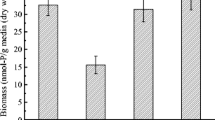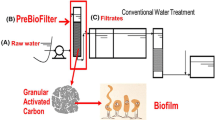Abstract
The biological activated carbon (BAC) is a popular advanced water treatment to the provision of safe water supply. A bench–scale device was designed to gain a better insight into microbial diversity and community structure of BAC biofilm by using high–throughput sequencing method. Both samples of BAC biofilm (the first, third and fifth month) and water (inlet water and outlet water of carbon filter, outlet water of backwashing) were analyzed to evaluate the impact of carbon filter depth, running time and backwash process. The results showed that the microbial diversity of biofilm decreased generally with the increase of carbon filter depth and biofilm reached a steady–state at the top layer of BAC after three months’ running. Proteobacteria (71.02%–95.61%) was found to be dominant bacteria both in biofilms and water samples. As one of opportunistic pathogen, the Pseudomonas aeruginosa in the outlet water of device (1.20%) was about eight times higher than that in the inlet water of device (0.16%) at the genus level after five–month operation. To maintain the safety of drinking water, the backwash used in this test could significantly remove Sphingobacteria (from 8.69% to 5.09%, p<0.05) of carbon biofilm. After backwashing, the operational taxonomic units (OTUs) number and the Shannon index decreased significantly (p<0.05) at the bottom of carbon column and we found the Proteobacteria increased by about 10% in all biofilm samples from different filter depth. This study reveals the transformation of BAC biofilm with the impact of running time and backwashing.
Similar content being viewed by others
References
Belila A, El–Chakhtoura J, Otaibi N, Muyzer G, Gonzalez–Gil G, Saikaly P E, van Loosdrecht M C M, Vrouwenvelder J S (2016). Bacterial community structure and variation in a full–scale seawater desalination plant for drinking water production. Water Research, 94: 62–72
Broszat M, Nacke H, Blasi R, Siebe C, Huebner J, Daniel R, Grohmann E (2014). Wastewater irrigation increases the abundance of potentially harmful gammaproteobacteria in soils in Mezquital Valley, Mexico. Applied and Environmental Microbiology, 80(17): 5282–5291
Caporaso J G, Lauber C L, Walters W A, Berg–Lyons D, Huntley J, Fierer N, Owens S M, Betley J, Fraser L, Bauer M, Gormley N, Gilbert J A, Smith G, Knight R (2012). Ultra–high–throughput microbial community analysis on the Illumina HiSeq and MiSeq platforms. ISME Journal, 6(8): 1621–1624
Cohen A, Zhang Q, Luo Q, Tao Y, Colford J M Jr, Ray I (2017). Predictors of drinking water boiling and bottled water consumption in rural China: A hierarchical modeling approach. Environmental Science & Technology, 51(12): 6945–6956
Cordaux R, Paces–Fessy M, Raimond M, Michel–Salzat A, Zimmer M, Bouchon D (2007). Molecular characterization and evolution of arthropod–pathogenic Rickettsiella bacteria. Applied and Environmental Microbiology, 73(15): 5045–5047
Dias MF, Reis MP, Acurcio L B, Carmo A O, Diamantino C F, Motta A M, Kalapothakis E, Nicoli J R, Nascimento A M A (2018). Changes in mouse gut bacterial community in response to different types of drinking water. Water Research, 132: 79–89
Douterelo I, Sharpe R L, Boxall J B (2013). Influence of hydraulic regimes on bacterial community structure and composition in an experimental drinking water distribution system. Water Research, 47 (2): 503–516
Edgar, R. C. (2013). UPARSE: highly accurate OTU sequences from microbial amplicon reads. Nature Methods, 10(10), 996
Gerrity D, Arnold M, Dickenson E, Moser D, Sackett J D, Wert E C (2018). Microbial community characterization of ozone–biofiltration systems in drinking water and potable reuse applications. Water Research, 135: 207–219
Gibert O, Lefèvre B, Fernández M, Bernat X, Paraira M, Calderer M, Martínez–Lladó X (2013). Characterising biofilm development on granular activated carbon used for drinking water production. Water Research, 47(3): 1101–1110
Hildenbrand Z L, Santos I C, Liden T, Carlton D D Jr, Varona–Torres E, Martin M S, Reyes M L, Mulla S R, Schug K A (2018). Characterizing variable biogeochemical changes during the treatment of produced oilfield waste. Science of the Total Environment, 634: 1519–1529
Hou L, Zhou Q, Wu Q, Gu Q, Sun M, Zhang J (2018). Spatiotemporal changes in bacterial community and microbial activity in a full–scale drinking water treatment plant. Science of the Total Environment, 625: 449–459
Hu A, Ju F, Hou L, Li J, Yang X, Wang H, Mulla S I, Sun Q, Bürgmann H, Yu C P (2017). Strong impact of anthropogenic contamination on the co–occurrence patterns of a riverine microbial community. Environmental Microbiology, 19(12): 4993–5009
Hunter P R, MacDonald A M, Carter R C (2010). Water supply and health. PLoS Medicine, 7(11): e1000361
Kim T G, Yun J, Hong S H, Cho K S (2014). Effects of water temperature and backwashing on bacterial population and community in a biological activated carbon process at a water treatment plant. Applied Microbiology and Biotechnology, 98(3): 1417–1427
LeBrun E S, King R S, Back J A, Kang S (2018). Microbial Community Structure and Function Decoupling Across a Phosphorus Gradient in Streams. Microbial Ecology, 75(1): 64–73
Li W, Wang F, Zhang J, Qiao Y, Xu C, Liu Y, Qian L, Li W, Dong B (2016). Community shift of biofilms developed in a full–scale drinking water distribution system switching from different water sources. Science of the Total Environment, 544: 499–506
Lin H, Zhang S, Zhang S, Lin W, Yu X (2017). The function of advanced treatment process in a drinking water treatment plant with organic matter–polluted source water. Environmental Science and Pollution Research International, 24(10): 8924–8932
Lou J C, Chan H Y, Han J Y, Yang C Y (2016). High removal of haloacetic acids from treated drinking water using bio–activated carbon method. Desalination and Water Treatment, 57(53): 25627–25638
Lou J C, Chang C J, Tseng W B, Han J Y (2015). Reducing the concentration of assimilable organic carbon (AOC) in treated drinking water. Urban Water Journal, 12(8): 672–677
Montoya–Pachongo C, Douterelo I, Noakes C, Camargo–Valero M A, Sleigh A, Escobar–Rivera J C, Torres–Lozada P (2018). Field assessment of bacterial communities and total trihalomethanes: Implications for drinking water networks. Science of the Total Environment, 616–617: 345–354
Park JW, Kim H C, Meyer A S, Kim S, Maeng S K (2016). Influences of NOM composition and bacteriological characteristics on biological stability in a full–scale drinking water treatment plant. Chemosphere, 160: 189–198
Pramanik B K, Roddick F A, Fan L (2016). Long–term operation of biological activated carbon pre–treatment for microfiltration of secondary effluent: Correlation between the organic foulants and fouling potential. Water Research, 90: 405–414
Pramanik B K, Roddick F A, Fan L, Jeong S, Vigneswaran S (2015). Assessment of biological activated carbon treatment to control membrane fouling in reverse osmosis of secondary effluent for reuse in irrigation. Desalination, 364: 90–95
Sharma D, Taylor–Edmonds L, Andrews R C (2018). Comparative assessment of ceramic media for drinking water biofiltration. Water Research, 128: 1–9
Simpson D R (2008). Biofilm processes in biologically active carbon water purification. Water Research, 42(12): 2839–2848
Su X, Hu J, Huang S, Ning K (2014). Rapid comparison and correlation analysis among massive number of microbial community samples based on MDV data model. Scientific Reports, 4(1): 6393
Velten S, Boller M, Köster O, Helbing J, Weilenmann H U, Hammes F (2011). Development of biomass in a drinking water granular active carbon (GAC) filter. Water Research, 45(19): 6347–6354
Wang F, Li W, Li Y, Zhang J, Chen J, Zhang W, Wu X (2018). Molecular analysis of bacterial community in the tap water with different water ages of a drinking water distribution system. Frontiers of Environmental Science & Engineering, 12(3): 6
Xu H, Pei H, Jin Y, Ma C, Wang Y, Sun J, Li H (2018). High–throughput sequencing reveals microbial communities in drinking water treatment sludge from six geographically distributed plants, including potentially toxic cyanobacteria and pathogens. Science of the Total Environment, 634: 769–779
Yang J S, Yuan D X, Weng T P (2010). Pilot study of drinking water treatment with GAC, O–3/BAC and membrane processes in Kinmen Island, Taiwan. Desalination, 263(1–3): 271–278
Zhang J, Li WY, Wang F, Qian L, Xu C, Liu Y, Qi W (2016). Exploring the biological stability situation of a full scale water distribution system in south China by three biological stability evaluation methods. Chemosphere, 161: 43–52
Acknowledgements
We are grateful for the cooperation and participation of the utilities that were involved in this project, which is supported by National Key Technology Research and Development Program of Research on urban water system construction and safety assurance technology in Xiong’an New Area of China (No. 2018ZX07110–0082).
Author information
Authors and Affiliations
Corresponding author
Rights and permissions
About this article
Cite this article
Qi, W., Li, W., Zhang, J. et al. Effect of biological activated carbon filter depth and backwashing process on transformation of biofilm community. Front. Environ. Sci. Eng. 13, 15 (2019). https://doi.org/10.1007/s11783-019-1100-0
Received:
Revised:
Accepted:
Published:
DOI: https://doi.org/10.1007/s11783-019-1100-0




